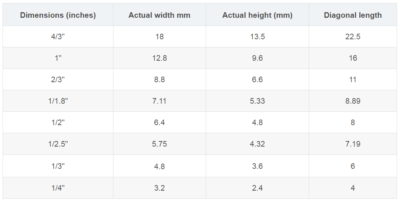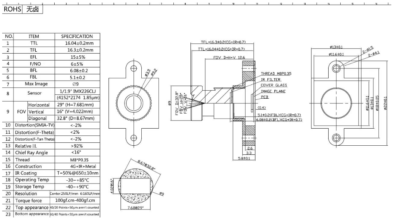Detailed explanation of camera module CMOS image sensor and lens parameter indicators
1. Sensor
1.1 Sensor size
Sensor size refers to the length of the diagonal in inches. The aspect ratio is usually 4:3. For historical reasons, 16mm is 1” in sensor.
Size (inches) Actual width mm Actual height mm Diagonal length
4/3″ 18 13.5 22.5
1″ 12.8 9.6 16
2/3 inch 8.8 6.6 11
1/1.8 inch 7.11 5.33 8.89
1/2″ 6.4 4.8 8
1/2.5 inch 5.75 4.32 7.19
1/3″ 4.8 3.6 6
1/4″ 3.2 2.4 4
1.2 CMOS Image Sensor Interface
MIPI/Digital Video Interface/LVDS
2. Lens
《Detailed explanation of optical lens parameters (EFL, TTL, BFL, FFL, FBL/FFL, FOV, F/NO, RI, MTF, TV-Line, Flare/Ghost)》

16mm: focal length 16mm
IR: infrared lens
1/2”: target surface size 1/2”
5MP: lens resolution, 500w pixels
F4.0: also written as F/4.0, aperture coefficient, 4.0 aperture, focal length/aperture; under other conditions unchanged, the smaller the aperture coefficient, the greater the luminous flux and the brighter the image.
Target surface size: corresponds to the size of the sensor, cannot be smaller than S ensor size, when it is smaller than the sensor size, there will be dark corners.
Focal length: The focal length of a fixed-focus lens is constant; the more convex the convex lens, the smaller the focal length; the flatter the convex lens, the larger the focal length. A zoom lens changes the focal length of the lens by changing the relative position of the lens inside the lens. The focal length of the lens is defined as the distance between the optical center of the lens and the image sensor (or film plane) of the camera when focusing at infinity. In some cases, the image distance is equivalent to the focal length.
Aperture value: F1.4, F2.0, F2.8, F4.0, F5.6, F8.0…, the next one is 1.4 times (root 2) of the previous one, and the luminous flux is half of the previous one.
Reference: Lens parameter index
2.1 The influence of lens focal length and aperture on depth of field
When the aperture remains unchanged, the focal length of the lens is inversely proportional to the depth of field:
The larger the focal length, the shallower the depth of field
The smaller the focal length, the greater the depth of field
When the focal length remains unchanged, the aperture size is inversely proportional to the depth of field:
The larger the aperture, the greater the depth of field
The smaller the aperture, the greater the depth of field
2.2 Lens interface
Threaded interface
It is divided into C-mount and CS-mount, the difference is that the flange distance (the distance from the lens mounting base to the focus) is different, that is, the distance between the bottom of the lens and the Senor is different.
The flange distance of the C-mount is 17.526mm, while that of the CS-mount is 12.5mm.
According to the interface diameter, it can be divided into M12, M42, etc. M12 refers to the interface diameter of 12mm.
Battery mount
Generally used in SLR cameras. It is divided into E-mount and EF-mount, and the difference is also the flange distance.
2.3 Total lens length TTL
The total optical length refers to the distance from the first surface of the lens in the lens to the image plane
The total length of the mechanism refers to the distance from the end face of the lens barrel to the image plane
When changing the lens, consider whether the total length of the lens is appropriate.
TTL affects the installation position. When TTL is too long, the sleeve may not be long enough, resulting in failure to install; this happened when we changed a lens.

This is the specification of a lens, TTL = 16mm.
TTL: Total optical length, the distance from the first surface of the lens to the image plane
TFL: Total lens length/total mechanism length, the distance from the end of the lens barrel to the image plane
EFL: Effective focal length
F/NO: Aperture size
FBL: Mechanism back focus (flange focal length), the distance from the last mechanism surface of the lens group to the image plane
BFL (Back Focal Length): Optical back focal length, the distance from the last surface of the lens to the image plane
FOV: Horizontal FOV, vertical FOV, diagonal FOV
Chief Ray Agnle: Main incident angle
Thread: Screw size, M8 diameter 8mm, P0.35 thread pitch 0.35mm
Construction: Structure, 4G+IR+Metal, 4 glass 4 glass lenses, infrared filter, metal housing
Resolution: Resolution, LP/mm, Line pairs per millimetre, line pairs per millimeter; for example 10 lp/mm means that there are 10 pairs of black and white lines in a length of 1mm, and there are 20 black and white lines in total, so the width of each line is 1/20 = 0.05mm
2.4 FOV field of view
FOV is affected by the aperture size; for the same lens, the larger the aperture, the larger the FOV, and the smaller the aperture, the smaller the FOV
The influence between field of view, aperture, and depth of field.
The larger the FOV, the smaller the image at the same distance, and the shallower the depth of field.
2.5 Equivalent focal length
When the size captured in the current sensor + current lens is the same as the size captured by the full-frame camera + lens, that is, when the field of view is the same, what is the focal length of the lens when shooting with a full-frame camera? This is the equivalent focal length, that is, the focal length of the lens used to capture an image with the same field of view with a full-frame camera.
2.6 Aperture
The aperture affects the amount of light entering. The larger the aperture, the more light enters, and the brighter the image.
Aperture affects depth of field. The larger the aperture, the smaller the depth of field.
When choosing a lens, you need to balance the amount of light entering and the depth of field according to the scene and choose a lens with a suitable aperture.
The reciprocal of the relative aperture (f’/D) is called the F number, also called the aperture number, recorded as F/….
The amount of light entering is inversely proportional to the square of the F number, that is, the amount of light entering the F4.0 aperture is half that of the F2.8, and the exposure time needs to be doubled.
3. Lens imaging principle
Image distance v: the distance from the lens to the sensor
Object distance u: the distance from the object to the lens
Focal length f: lens focal length parameter; fixed-focus lens, fixed focal length; zoom lens, variable focal length
Autofocus and autofocus: autofocus AF, focal length remains unchanged, adjust image distance and object distance (mainly image distance); autofocus zoom, adjust focal length, object distance and image distance remain unchanged
3.1 Convex lens imaging principle
The convex lens imaging principle refers to the imaging principle using the refraction of light.
u>2f, f<v<2f: inverted and reduced real image (camera application)
u=2f=v: inverted and equal real image
f<u<2f, v>2f: inverted and enlarged real image (projector)
Imaging formula: 1/u + 1/v = 1/f, only when this condition is met can a clear image be formed.
In the camera, usually u >>> v, the object distance is much larger than the image distance. Therefore, in the AF autofocus process, a small change in the image distance v can cause a large change in the object distance u. Therefore, the distance pushed by the VCM is usually very short, but it can control a large clear imaging range.
Image size:
When f remains unchanged, the image distance v increases, the object distance u decreases, and the image becomes larger (u+v decreases) (When AF VCM is pushed outward, the clear point is closer, and the image of the object becomes larger)
When f remains unchanged, the image distance v decreases, the object distance u increases, and the image becomes smaller (u+v increases)
If you change to a lens with a longer focal length, the image distance remains unchanged, and the object distance must also be reduced; if you do not want to reduce the object distance, you must reduce the image distance.
3.2 The influence of different light on focal length
Light of different wavelengths has different propagation speeds and refractive indices in the medium, so the same lens has different focal lengths for light of different wavelengths. This is called dispersion, which is the same as the dispersion of a prism. The longer the wavelength, the larger the focal length.
The wavelength range of different colors of visible light:
Red: 770~622nm; Orange: 622~597nm; Yellow: 597~577nm; Green: 577~492nm; Blue, Indigo: 492~455nm; Purple: 455~350nm.
Then let’s think about a problem. In surveillance cameras, color video images are used during the day, while infrared video images are used at night. If the focus must have changed before and after the IR CUT is switched, it is necessary to refocus.
In order to meet the needs of 24-hour surveillance, many places require cameras to not only complete surveillance tasks during the day, but also present clear images at night. In addition, in recent years, infrared cameras and infrared lights have become popular, and the prices of day and night cameras and high-definition color cameras have dropped to a certain extent, providing lens manufacturers with a lot of market opportunities. IR surveillance camera lenses were born in this way.
IR lens is an infrared lens. It uses special optical glass materials and the latest optical design methods to eliminate the focal plane offset of visible light and infrared light. Therefore, light from visible light to infrared light can be imaged on the same focal plane, making the image clear. In addition, IR infrared lens also uses special multi-layer coating technology to increase the transmittance of infrared light, so the camera with IR lens can monitor farther at night than the camera with ordinary lens, and the effect is better.


